FNSACC408: Work Effectively in the Accounting & Bookkeeping Industry
VerifiedAdded on 2023/05/31
|17
|2377
|143
Homework Assignment
AI Summary
This document presents a comprehensive solution to an assessment task for the FNSACC40217 Certificate IV in Accounting and Bookkeeping, focusing on working effectively within the accounting and bookkeeping industry. The solution covers various aspects, including client communication, roles of accountants and bookkeepers, understanding business needs, and maintaining proper accounting records. It addresses key areas such as GST registration, PAYG withholding, Fringe Benefits Tax, and payroll tax. Furthermore, the document includes discussions on accounting systems, petty cash management, accounts receivable processes, and the impact of technology on accounting practices. The solution also incorporates elements of team environment, employee motivation, and professional development, providing a holistic view of effective practices in the accounting and bookkeeping sector. Desklib offers a platform to explore more solved assignments and study resources for students.
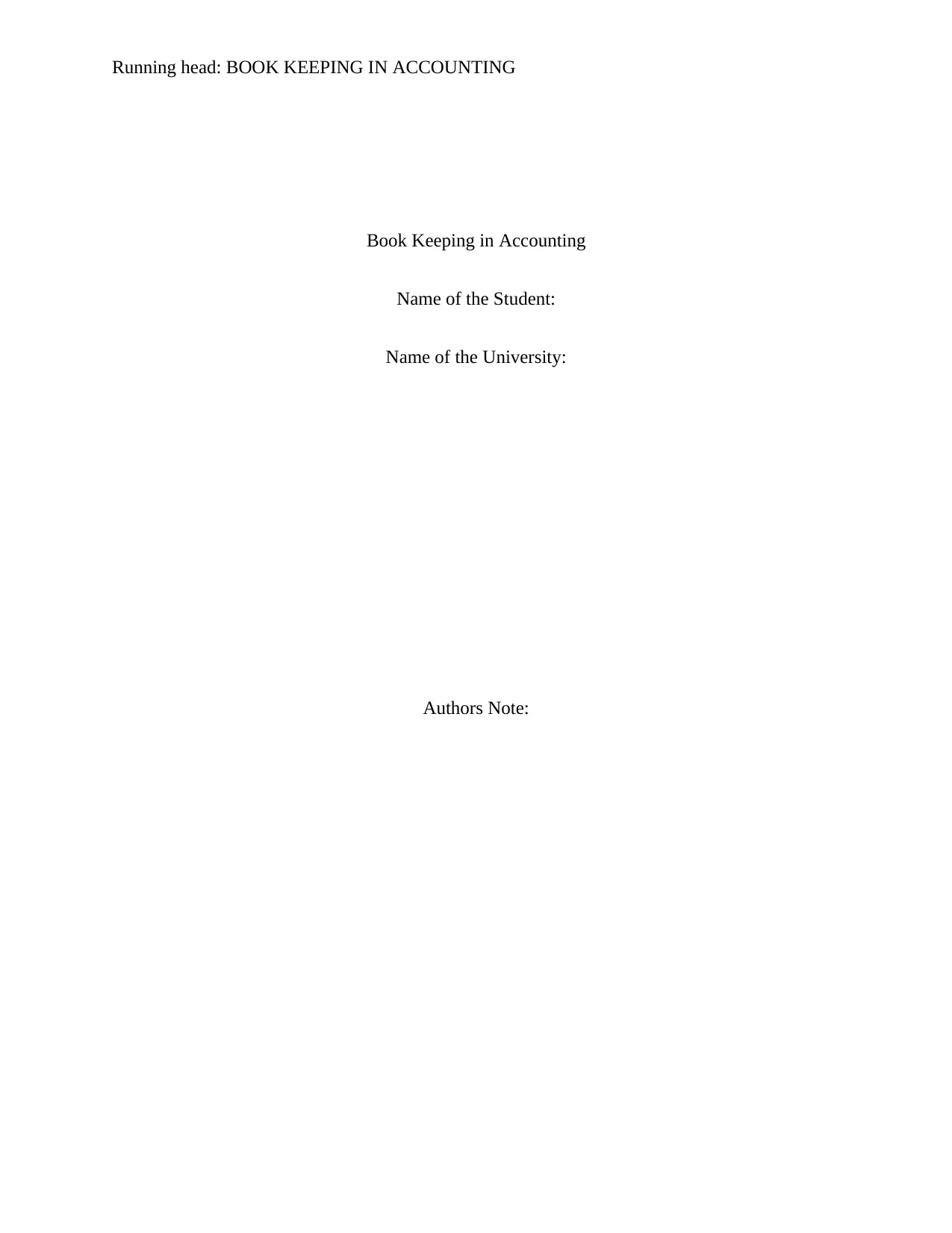
Running head: BOOK KEEPING IN ACCOUNTING
Book Keeping in Accounting
Name of the Student:
Name of the University:
Authors Note:
Book Keeping in Accounting
Name of the Student:
Name of the University:
Authors Note:
Paraphrase This Document
Need a fresh take? Get an instant paraphrase of this document with our AI Paraphraser
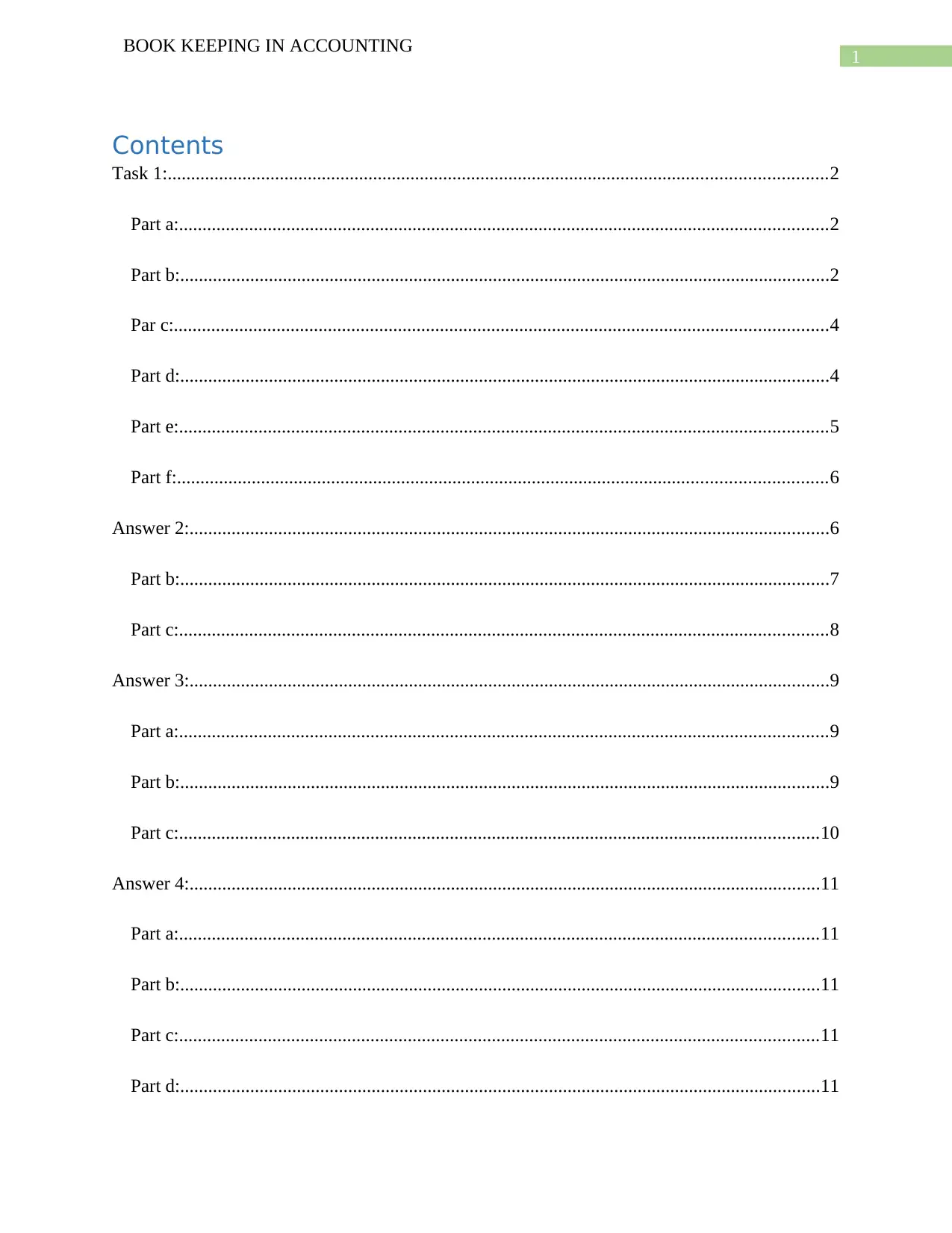
1
BOOK KEEPING IN ACCOUNTING
Contents
Task 1:.............................................................................................................................................2
Part a:...........................................................................................................................................2
Part b:...........................................................................................................................................2
Par c:............................................................................................................................................4
Part d:...........................................................................................................................................4
Part e:...........................................................................................................................................5
Part f:...........................................................................................................................................6
Answer 2:.........................................................................................................................................6
Part b:...........................................................................................................................................7
Part c:...........................................................................................................................................8
Answer 3:.........................................................................................................................................9
Part a:...........................................................................................................................................9
Part b:...........................................................................................................................................9
Part c:.........................................................................................................................................10
Answer 4:.......................................................................................................................................11
Part a:.........................................................................................................................................11
Part b:.........................................................................................................................................11
Part c:.........................................................................................................................................11
Part d:.........................................................................................................................................11
BOOK KEEPING IN ACCOUNTING
Contents
Task 1:.............................................................................................................................................2
Part a:...........................................................................................................................................2
Part b:...........................................................................................................................................2
Par c:............................................................................................................................................4
Part d:...........................................................................................................................................4
Part e:...........................................................................................................................................5
Part f:...........................................................................................................................................6
Answer 2:.........................................................................................................................................6
Part b:...........................................................................................................................................7
Part c:...........................................................................................................................................8
Answer 3:.........................................................................................................................................9
Part a:...........................................................................................................................................9
Part b:...........................................................................................................................................9
Part c:.........................................................................................................................................10
Answer 4:.......................................................................................................................................11
Part a:.........................................................................................................................................11
Part b:.........................................................................................................................................11
Part c:.........................................................................................................................................11
Part d:.........................................................................................................................................11
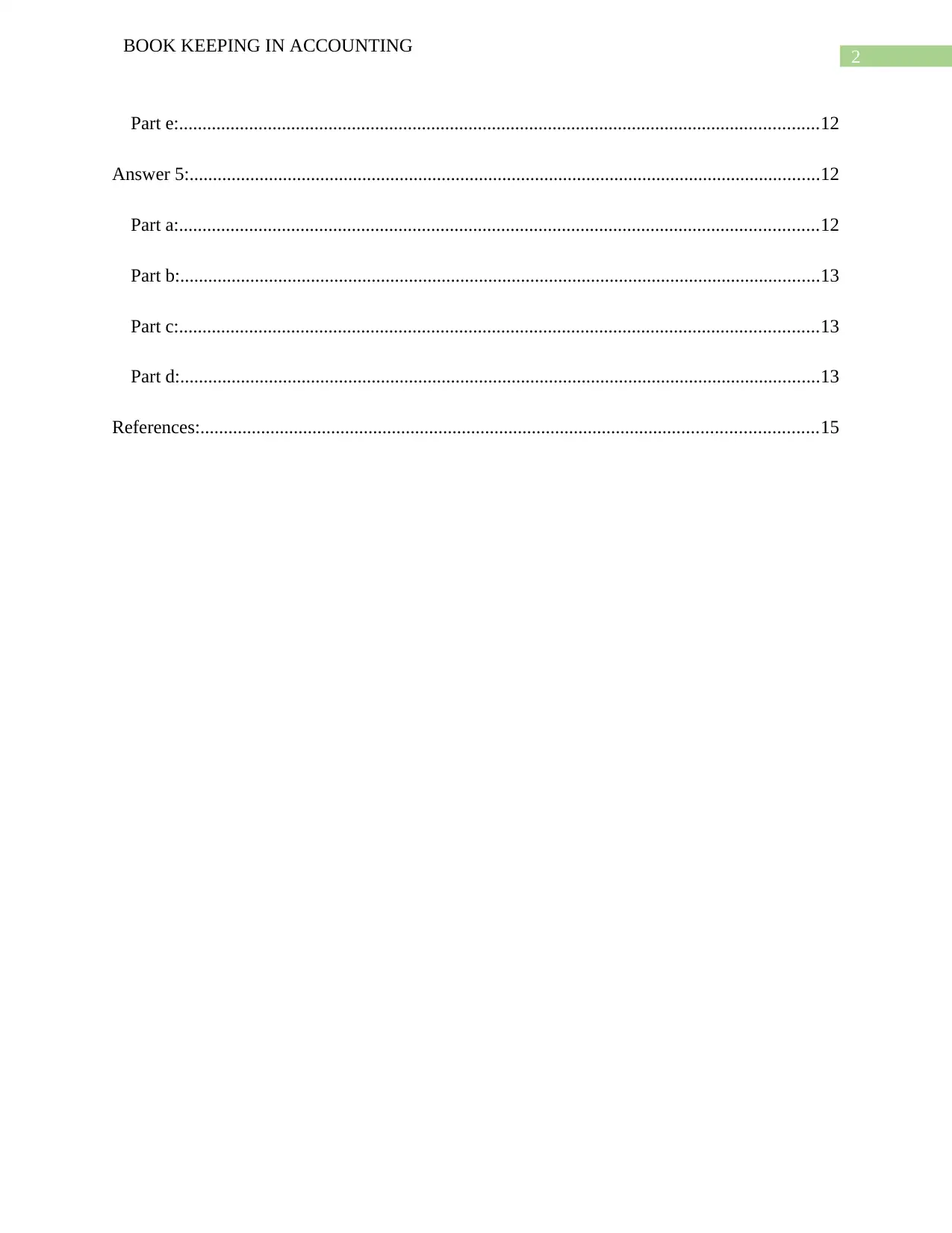
2
BOOK KEEPING IN ACCOUNTING
Part e:.........................................................................................................................................12
Answer 5:.......................................................................................................................................12
Part a:.........................................................................................................................................12
Part b:.........................................................................................................................................13
Part c:.........................................................................................................................................13
Part d:.........................................................................................................................................13
References:....................................................................................................................................15
BOOK KEEPING IN ACCOUNTING
Part e:.........................................................................................................................................12
Answer 5:.......................................................................................................................................12
Part a:.........................................................................................................................................12
Part b:.........................................................................................................................................13
Part c:.........................................................................................................................................13
Part d:.........................................................................................................................................13
References:....................................................................................................................................15
⊘ This is a preview!⊘
Do you want full access?
Subscribe today to unlock all pages.

Trusted by 1+ million students worldwide
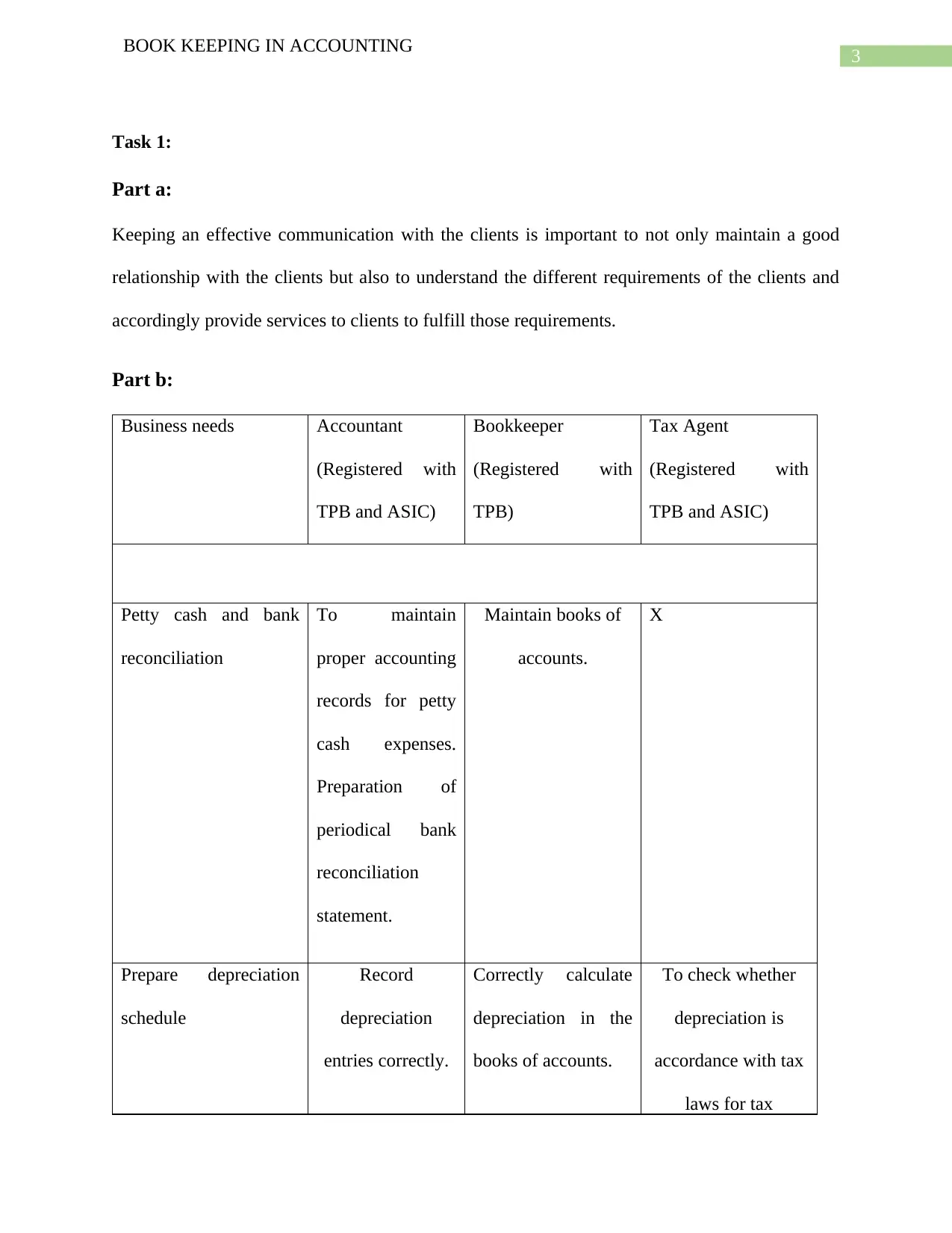
3
BOOK KEEPING IN ACCOUNTING
Task 1:
Part a:
Keeping an effective communication with the clients is important to not only maintain a good
relationship with the clients but also to understand the different requirements of the clients and
accordingly provide services to clients to fulfill those requirements.
Part b:
Business needs Accountant
(Registered with
TPB and ASIC)
Bookkeeper
(Registered with
TPB)
Tax Agent
(Registered with
TPB and ASIC)
Petty cash and bank
reconciliation
To maintain
proper accounting
records for petty
cash expenses.
Preparation of
periodical bank
reconciliation
statement.
Maintain books of
accounts.
X
Prepare depreciation
schedule
Record
depreciation
entries correctly.
Correctly calculate
depreciation in the
books of accounts.
To check whether
depreciation is
accordance with tax
laws for tax
BOOK KEEPING IN ACCOUNTING
Task 1:
Part a:
Keeping an effective communication with the clients is important to not only maintain a good
relationship with the clients but also to understand the different requirements of the clients and
accordingly provide services to clients to fulfill those requirements.
Part b:
Business needs Accountant
(Registered with
TPB and ASIC)
Bookkeeper
(Registered with
TPB)
Tax Agent
(Registered with
TPB and ASIC)
Petty cash and bank
reconciliation
To maintain
proper accounting
records for petty
cash expenses.
Preparation of
periodical bank
reconciliation
statement.
Maintain books of
accounts.
X
Prepare depreciation
schedule
Record
depreciation
entries correctly.
Correctly calculate
depreciation in the
books of accounts.
To check whether
depreciation is
accordance with tax
laws for tax
Paraphrase This Document
Need a fresh take? Get an instant paraphrase of this document with our AI Paraphraser
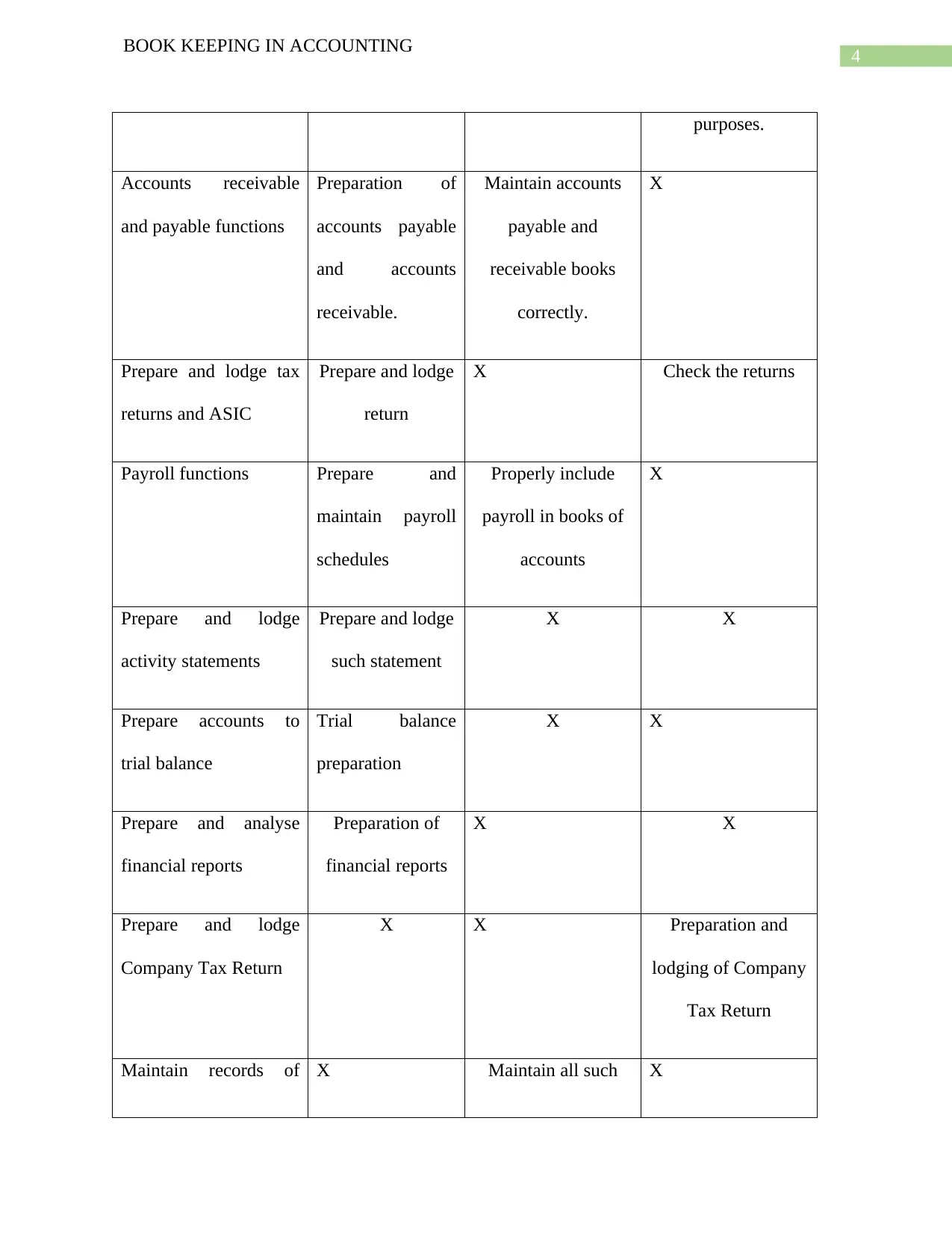
4
BOOK KEEPING IN ACCOUNTING
purposes.
Accounts receivable
and payable functions
Preparation of
accounts payable
and accounts
receivable.
Maintain accounts
payable and
receivable books
correctly.
X
Prepare and lodge tax
returns and ASIC
Prepare and lodge
return
X Check the returns
Payroll functions Prepare and
maintain payroll
schedules
Properly include
payroll in books of
accounts
X
Prepare and lodge
activity statements
Prepare and lodge
such statement
X X
Prepare accounts to
trial balance
Trial balance
preparation
X X
Prepare and analyse
financial reports
Preparation of
financial reports
X X
Prepare and lodge
Company Tax Return
X X Preparation and
lodging of Company
Tax Return
Maintain records of X Maintain all such X
BOOK KEEPING IN ACCOUNTING
purposes.
Accounts receivable
and payable functions
Preparation of
accounts payable
and accounts
receivable.
Maintain accounts
payable and
receivable books
correctly.
X
Prepare and lodge tax
returns and ASIC
Prepare and lodge
return
X Check the returns
Payroll functions Prepare and
maintain payroll
schedules
Properly include
payroll in books of
accounts
X
Prepare and lodge
activity statements
Prepare and lodge
such statement
X X
Prepare accounts to
trial balance
Trial balance
preparation
X X
Prepare and analyse
financial reports
Preparation of
financial reports
X X
Prepare and lodge
Company Tax Return
X X Preparation and
lodging of Company
Tax Return
Maintain records of X Maintain all such X
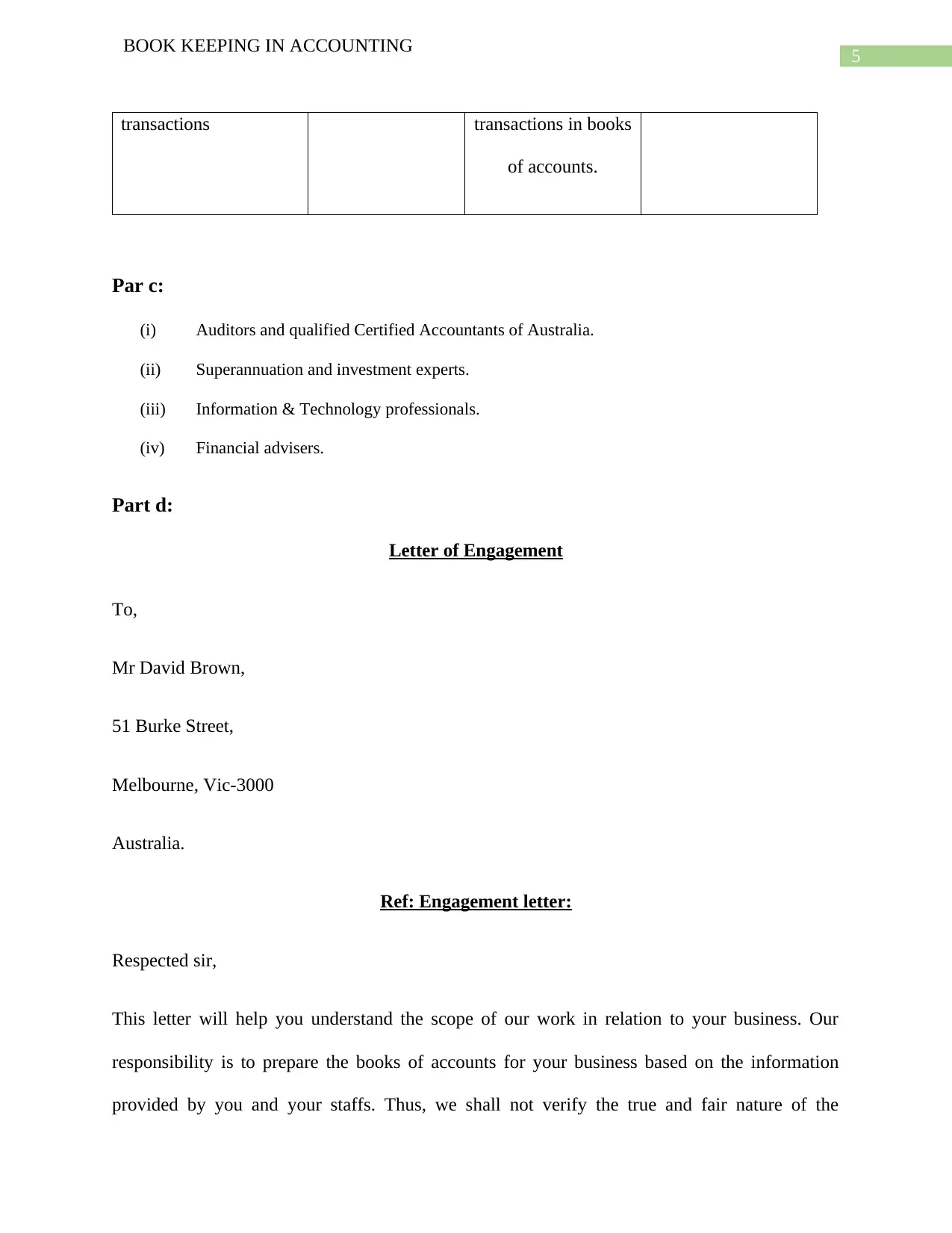
5
BOOK KEEPING IN ACCOUNTING
transactions transactions in books
of accounts.
Par c:
(i) Auditors and qualified Certified Accountants of Australia.
(ii) Superannuation and investment experts.
(iii) Information & Technology professionals.
(iv) Financial advisers.
Part d:
Letter of Engagement
To,
Mr David Brown,
51 Burke Street,
Melbourne, Vic-3000
Australia.
Ref: Engagement letter:
Respected sir,
This letter will help you understand the scope of our work in relation to your business. Our
responsibility is to prepare the books of accounts for your business based on the information
provided by you and your staffs. Thus, we shall not verify the true and fair nature of the
BOOK KEEPING IN ACCOUNTING
transactions transactions in books
of accounts.
Par c:
(i) Auditors and qualified Certified Accountants of Australia.
(ii) Superannuation and investment experts.
(iii) Information & Technology professionals.
(iv) Financial advisers.
Part d:
Letter of Engagement
To,
Mr David Brown,
51 Burke Street,
Melbourne, Vic-3000
Australia.
Ref: Engagement letter:
Respected sir,
This letter will help you understand the scope of our work in relation to your business. Our
responsibility is to prepare the books of accounts for your business based on the information
provided by you and your staffs. Thus, we shall not verify the true and fair nature of the
⊘ This is a preview!⊘
Do you want full access?
Subscribe today to unlock all pages.

Trusted by 1+ million students worldwide

6
BOOK KEEPING IN ACCOUNTING
information. It is not an audit engagement rather an engagement to maintain the books of
accounts to record financial transactions of your business in the books of accounts. The books of
accounts shall be prepared in accordance with the applicable accounting standards to the nature
of business carried out by you. Up-to-date accounting records shall be maintained and provided
to your staffs as and when required to enable them to take important business decisions. The
information collected about your business shall not be disclosed by us to anyone without your
permission and as required under the laws (Guthrie and Parker, 2016). In case of any
contravention with the terms and conditions of the engagement then the engagement shall be
liable to be cancelled based on your final assessment and decision on the issue.
Please carefully read the above letter and acknowledge the engagement letter. In case of any
confusion with any points of the letter please do not hesitate to contact.
Regards,
(Name of the student)
Part e:
1. Have the necessary information required by the client has been made available to the client as and
when needed?
2. Do the client have up-to-date accounting information to assess and evaluate the financial position
of the business at any point of time?
3. Is the books of accounts have been prepared correctly as per the accounting standards in the
country?
Part f:
1. Integrity.
BOOK KEEPING IN ACCOUNTING
information. It is not an audit engagement rather an engagement to maintain the books of
accounts to record financial transactions of your business in the books of accounts. The books of
accounts shall be prepared in accordance with the applicable accounting standards to the nature
of business carried out by you. Up-to-date accounting records shall be maintained and provided
to your staffs as and when required to enable them to take important business decisions. The
information collected about your business shall not be disclosed by us to anyone without your
permission and as required under the laws (Guthrie and Parker, 2016). In case of any
contravention with the terms and conditions of the engagement then the engagement shall be
liable to be cancelled based on your final assessment and decision on the issue.
Please carefully read the above letter and acknowledge the engagement letter. In case of any
confusion with any points of the letter please do not hesitate to contact.
Regards,
(Name of the student)
Part e:
1. Have the necessary information required by the client has been made available to the client as and
when needed?
2. Do the client have up-to-date accounting information to assess and evaluate the financial position
of the business at any point of time?
3. Is the books of accounts have been prepared correctly as per the accounting standards in the
country?
Part f:
1. Integrity.
Paraphrase This Document
Need a fresh take? Get an instant paraphrase of this document with our AI Paraphraser
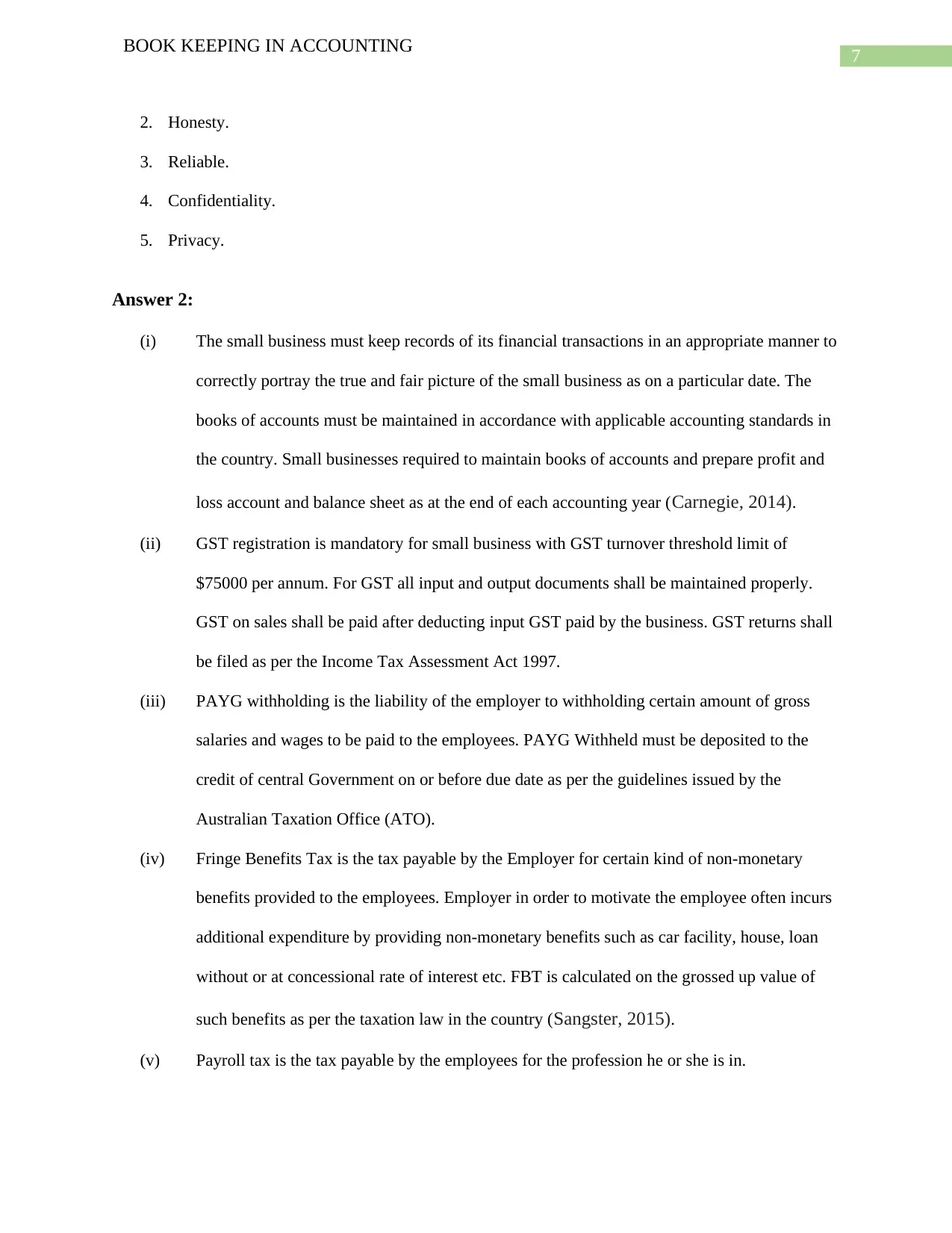
7
BOOK KEEPING IN ACCOUNTING
2. Honesty.
3. Reliable.
4. Confidentiality.
5. Privacy.
Answer 2:
(i) The small business must keep records of its financial transactions in an appropriate manner to
correctly portray the true and fair picture of the small business as on a particular date. The
books of accounts must be maintained in accordance with applicable accounting standards in
the country. Small businesses required to maintain books of accounts and prepare profit and
loss account and balance sheet as at the end of each accounting year (Carnegie, 2014).
(ii) GST registration is mandatory for small business with GST turnover threshold limit of
$75000 per annum. For GST all input and output documents shall be maintained properly.
GST on sales shall be paid after deducting input GST paid by the business. GST returns shall
be filed as per the Income Tax Assessment Act 1997.
(iii) PAYG withholding is the liability of the employer to withholding certain amount of gross
salaries and wages to be paid to the employees. PAYG Withheld must be deposited to the
credit of central Government on or before due date as per the guidelines issued by the
Australian Taxation Office (ATO).
(iv) Fringe Benefits Tax is the tax payable by the Employer for certain kind of non-monetary
benefits provided to the employees. Employer in order to motivate the employee often incurs
additional expenditure by providing non-monetary benefits such as car facility, house, loan
without or at concessional rate of interest etc. FBT is calculated on the grossed up value of
such benefits as per the taxation law in the country (Sangster, 2015).
(v) Payroll tax is the tax payable by the employees for the profession he or she is in.
BOOK KEEPING IN ACCOUNTING
2. Honesty.
3. Reliable.
4. Confidentiality.
5. Privacy.
Answer 2:
(i) The small business must keep records of its financial transactions in an appropriate manner to
correctly portray the true and fair picture of the small business as on a particular date. The
books of accounts must be maintained in accordance with applicable accounting standards in
the country. Small businesses required to maintain books of accounts and prepare profit and
loss account and balance sheet as at the end of each accounting year (Carnegie, 2014).
(ii) GST registration is mandatory for small business with GST turnover threshold limit of
$75000 per annum. For GST all input and output documents shall be maintained properly.
GST on sales shall be paid after deducting input GST paid by the business. GST returns shall
be filed as per the Income Tax Assessment Act 1997.
(iii) PAYG withholding is the liability of the employer to withholding certain amount of gross
salaries and wages to be paid to the employees. PAYG Withheld must be deposited to the
credit of central Government on or before due date as per the guidelines issued by the
Australian Taxation Office (ATO).
(iv) Fringe Benefits Tax is the tax payable by the Employer for certain kind of non-monetary
benefits provided to the employees. Employer in order to motivate the employee often incurs
additional expenditure by providing non-monetary benefits such as car facility, house, loan
without or at concessional rate of interest etc. FBT is calculated on the grossed up value of
such benefits as per the taxation law in the country (Sangster, 2015).
(v) Payroll tax is the tax payable by the employees for the profession he or she is in.
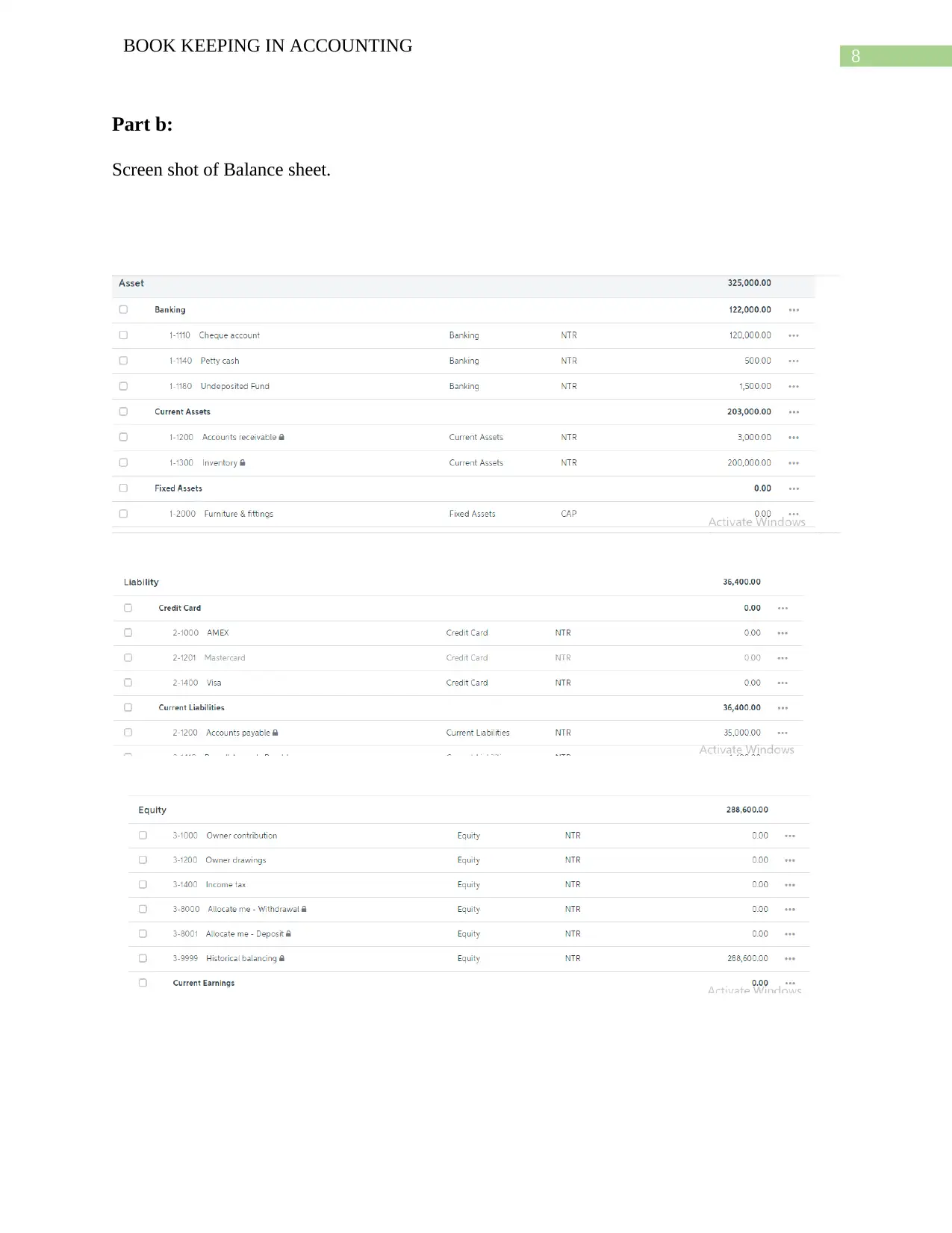
8
BOOK KEEPING IN ACCOUNTING
Part b:
Screen shot of Balance sheet.
BOOK KEEPING IN ACCOUNTING
Part b:
Screen shot of Balance sheet.
⊘ This is a preview!⊘
Do you want full access?
Subscribe today to unlock all pages.

Trusted by 1+ million students worldwide

9
BOOK KEEPING IN ACCOUNTING
Part c:
Requirement Authority Research source
Business Activity
Statement (BAS)
requirements
Australian Taxation
Office (ATO)
www.ato.gov.au
Australian Accounting
Standards
Australian Accounting
Standards Board
(AASB)
www.aasb.gov.au
Tax Practitioners
Board requirements
Tax Practitioners
Board (TPB)
www.tbp.gov.au
Privacy Act Office of the
Australian Information
Commission
www.oaic.gov.au/privacy-law/
Taxation Act Income Tax
Assessment Act 1997
www.legislation.gov.au/Details/C2017C00336
BOOK KEEPING IN ACCOUNTING
Part c:
Requirement Authority Research source
Business Activity
Statement (BAS)
requirements
Australian Taxation
Office (ATO)
www.ato.gov.au
Australian Accounting
Standards
Australian Accounting
Standards Board
(AASB)
www.aasb.gov.au
Tax Practitioners
Board requirements
Tax Practitioners
Board (TPB)
www.tbp.gov.au
Privacy Act Office of the
Australian Information
Commission
www.oaic.gov.au/privacy-law/
Taxation Act Income Tax
Assessment Act 1997
www.legislation.gov.au/Details/C2017C00336
Paraphrase This Document
Need a fresh take? Get an instant paraphrase of this document with our AI Paraphraser

10
BOOK KEEPING IN ACCOUNTING
Trade Practices Act Federal Register of
Legislation
www.legislation.gov.au/Details/C2010C00426
Answer 3:
Part a:
I. Accounting system.
II. Information system.
III. Management system.
IV. Data processing system.
Part b:
Development of petty cash system policy:
The cash disbursed for petty cash expenses by the cashier shall be recorded as receipt in petty
cash system. The different petty cash expenses incurred from such amount shall be recorded as
payments in the petty cash system. The balance in petty cash system after petty cash
expenditures if negative then the amount shall be reimbursed by the cashier. In case the amount
is positive then the amounts shall be transferred to the cashier (Chenhall and Moers, 2015).
BOOK KEEPING IN ACCOUNTING
Trade Practices Act Federal Register of
Legislation
www.legislation.gov.au/Details/C2010C00426
Answer 3:
Part a:
I. Accounting system.
II. Information system.
III. Management system.
IV. Data processing system.
Part b:
Development of petty cash system policy:
The cash disbursed for petty cash expenses by the cashier shall be recorded as receipt in petty
cash system. The different petty cash expenses incurred from such amount shall be recorded as
payments in the petty cash system. The balance in petty cash system after petty cash
expenditures if negative then the amount shall be reimbursed by the cashier. In case the amount
is positive then the amounts shall be transferred to the cashier (Chenhall and Moers, 2015).
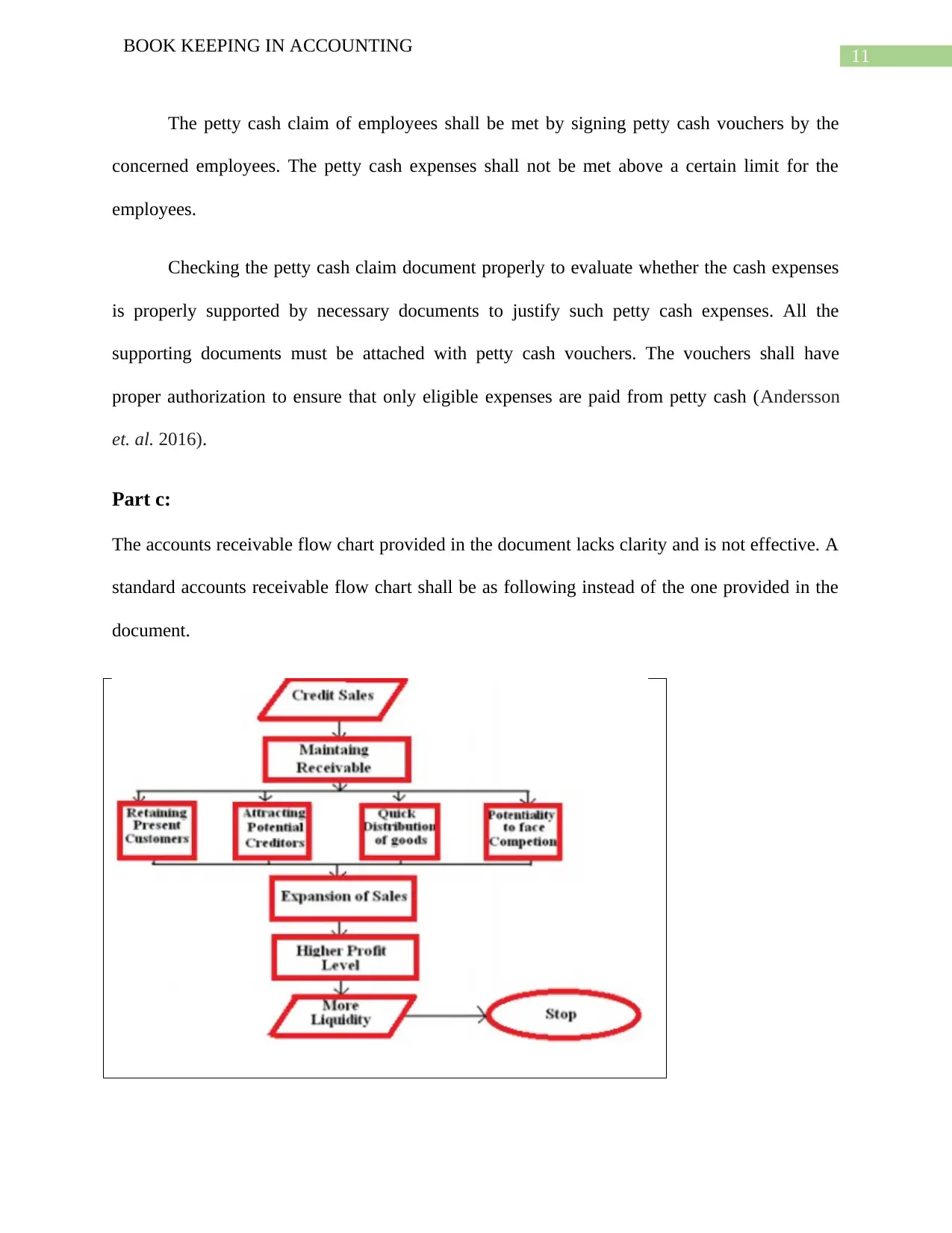
11
BOOK KEEPING IN ACCOUNTING
The petty cash claim of employees shall be met by signing petty cash vouchers by the
concerned employees. The petty cash expenses shall not be met above a certain limit for the
employees.
Checking the petty cash claim document properly to evaluate whether the cash expenses
is properly supported by necessary documents to justify such petty cash expenses. All the
supporting documents must be attached with petty cash vouchers. The vouchers shall have
proper authorization to ensure that only eligible expenses are paid from petty cash (Andersson
et. al. 2016).
Part c:
The accounts receivable flow chart provided in the document lacks clarity and is not effective. A
standard accounts receivable flow chart shall be as following instead of the one provided in the
document.
BOOK KEEPING IN ACCOUNTING
The petty cash claim of employees shall be met by signing petty cash vouchers by the
concerned employees. The petty cash expenses shall not be met above a certain limit for the
employees.
Checking the petty cash claim document properly to evaluate whether the cash expenses
is properly supported by necessary documents to justify such petty cash expenses. All the
supporting documents must be attached with petty cash vouchers. The vouchers shall have
proper authorization to ensure that only eligible expenses are paid from petty cash (Andersson
et. al. 2016).
Part c:
The accounts receivable flow chart provided in the document lacks clarity and is not effective. A
standard accounts receivable flow chart shall be as following instead of the one provided in the
document.
⊘ This is a preview!⊘
Do you want full access?
Subscribe today to unlock all pages.

Trusted by 1+ million students worldwide
1 out of 17
Related Documents
Your All-in-One AI-Powered Toolkit for Academic Success.
+13062052269
info@desklib.com
Available 24*7 on WhatsApp / Email
![[object Object]](/_next/static/media/star-bottom.7253800d.svg)
Unlock your academic potential
Copyright © 2020–2025 A2Z Services. All Rights Reserved. Developed and managed by ZUCOL.





